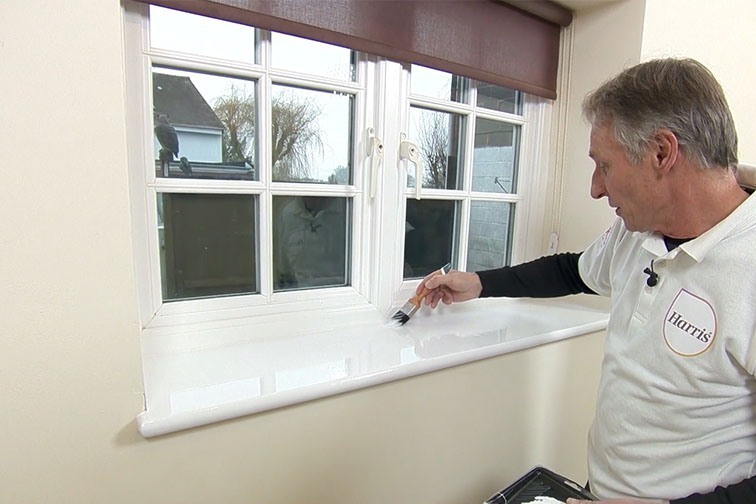Paint Bathroom Window
How to Paint a Window Sill
Consult our fast, effective guide today, learn how to paint a window sill the Harris way and tick this DIY task off your to-do list!
As the area of the home where vases, candles and picture frames often take pride of place and create a stunning focal point, our window sills deserve just as much attention as the rest of the home. Wooden window sills and window frames can attract a lot of moisture in older homes and fall into disrepair all too easily, making the home look unkempt. If you're looking for expert tips on painting a window sill or are interested in finding out the best brush to paint a window sill with an incredibly even finish, follow our easy steps and create the perfect window area to daydream from.

When it comes to painting a window sill like a professional, the first step is always to ready the area for painting. First, remove any furniture or décor from the room to avoid obstruction and damage to your belongings. Next, take down your curtains and blinds from the window area you're looking to paint and lay a Seriously Good Dust Sheet down to protect the area from dust and prevent paint from seeping through and causing stains to your flooring. To secure your dust sheet in place whilst protecting the windows and wall around the window sill and window frame, use some Seriously Good UV Masking Tape. Now on to the surface preparation!
Wood preparation can be a challenge as areas of trim such as window sills can often be neglected for extended periods.
To achieve a smooth, matt surface that is ready for painting, begin sanding the wood using the Ultimate Aluminium Oxide Fine Paper in gentle, circular motions to remove old paint and imperfections. Repeat this step using the Seriously Good Fine Sanding Block to ensure that all old paint has been removed. For more thick, stubborn paint, you may need to wear protective equipment including Seriously Good Nitrile Gloves and Seriously Good Safety Glasses before applying paint stripper to the wall. Pour some of the paint stripper into a small metal or glass container and apply to the desired area. Be sure to closely follow guidance and safety procedures on the back of the product to achieve the best possible results.


Once all paint has been removed, the next step after sanding is cleaning the dust away using a Seriously Good Microfibre Cleaning Cloth. You then need to assess the surface of the wood again and repair of any holes or cracks in the woodwork using filler. Once the wood filler has cured, sand and clean the surface once more using Ultimate Aluminium Oxide Paper Fine and sugar soap to make sure your paint applies perfectly.
The key to painting a window sill smoothly is applying a high performing primer. Two main areas need to be primed in this step; the first is any detail areas and second is the window frame and edges of the window sill. We recommend opting for a stain block primer to mitigate any sap or contaminants from spoiling the wood and the paintwork. To help ensure even coverage when applying the primer, take the Ultimate Angled Gloss Brush.

For larger flat areas such as the shelf of the window sill, use the Ultimate Woodwork Gloss Roller 4" Set to speed up the process and paint effortlessly. When you have finished applying the priming coat, clean the brushes using some white spirit in a sealable jar, such as a mason jar or jam jar to prevent sink blockages. Work the white spirit into the brush and then wipe away the paint with some Seriously Good Paper Towel. Repeat this easy cleaning process as necessary until the brush is fully clean and ready to be reused in the exciting final step! Remember, you cannot re-use the gloss roller sleeve, but you can wrap it in cling film for use priming another part of the house. This should keep the roller sleeve moist and usable for around 48 hours.

Before applying the top coat when painting a window sill, it is advisable to give the primed surface a quick, light sand using some Ultimate Aluminium Oxide Fine Paper. This quick step helps to remove any annoying brush marks from the priming stage and gives a much smoother, more professional-looking finish. Clean the area one final time with a Seriously Good Microfibre Cleaning Cloth to effectively remove dust from the area.
Repeat the painting steps using the Ultimate Angled Gloss Brush for areas of detail and the Ultimate Woodwork Gloss Roller 4" Set for the flat surfaces for your top coat. Don't forget, you can clean your expert painting tools and ensure they offer maximum performance again and again by using white spirit to quickly remove the gloss paint.
Enjoyed this guide on how to paint a window sill? Head to our How to Get a Smooth Finish with Gloss Paint to examine these steps in more detail and perfect the magical process needed to get a glass-like finish on your wooden trim!
Browse our How To, Let's Plan and Tip Exchange sections today to find more home inspiration and useful DIY tips to take your projects to the next level.

Source: https://harrisbrushes.com/how-to-guides/how-to-paint-a-window-sill/


0 Komentar